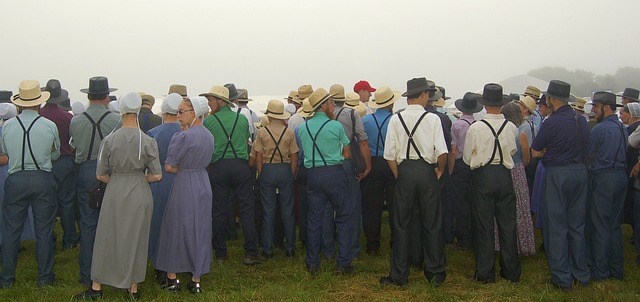The Amish community is known for their traditional and conservative lifestyle, which often includes abstaining from modern technology. However, when it comes to transportation, there are some variations within different Amish groups. One common question that arises is whether Amish individuals are allowed to ride bicycles.
Table of Contents
The History of Bicycles in Amish Communities
Can Amish Ride Bikes?
When you think of the Amish, you might picture horse-drawn buggies and a simple, traditional way of life. But what about bicycles? Can Amish ride bikes? The answer is not as straightforward as you might think. Let’s take a closer look at the history of bicycles in Amish communities to understand the complexities of this question.
Bicycles have been around for centuries, but they didn’t become popular until the late 19th century. As the world embraced this new mode of transportation, the Amish faced a dilemma. Their religious beliefs emphasize simplicity and humility, and some members of the community saw bicycles as a potential threat to these values. After all, bicycles offered a faster and more convenient way to travel, which could lead to a desire for more worldly possessions.
Despite these concerns, some Amish communities did allow bicycles. In the early 20th century, bicycles were seen as a practical tool for transportation, especially for young people who needed to travel longer distances. However, there were strict rules and guidelines surrounding their use. Bicycles were not to be used for leisure or recreation, but solely for practical purposes like going to work or running errands.
Over time, attitudes towards bicycles in Amish communities began to shift. As technology advanced and bicycles became more sophisticated, some members of the community worried that they were becoming too worldly. This led to a divide within the Amish, with some groups embracing bicycles as a useful tool and others rejecting them altogether.
Today, the use of bicycles in Amish communities varies depending on the specific group and their interpretation of the Ordnung, the set of rules that govern Amish life. Some communities still prohibit the use of bicycles entirely, while others allow them with certain restrictions. For example, some groups may only allow bicycles with plain, non-flashy designs, while others may require members to remove any gears or other modern features.
The decision to allow or prohibit bicycles is not taken lightly in Amish communities. It is a reflection of their commitment to living a simple and humble life, free from the distractions and temptations of the modern world. While some may see this as restrictive, the Amish view it as a way to preserve their values and maintain a strong sense of community.
In recent years, there has been a growing interest in alternative forms of transportation, including bicycles, among the Amish. Some communities have recognized the environmental benefits of cycling and have started to embrace it as a more sustainable mode of transportation. This has led to a reevaluation of the rules surrounding bicycles and a more open-minded approach towards their use.
So, can Amish ride bikes? The answer is not a simple yes or no. It depends on the specific Amish community and their interpretation of their religious beliefs. While some communities still prohibit bicycles, others have embraced them as a practical and sustainable mode of transportation. Regardless of their stance, the Amish continue to navigate the complexities of modern life while staying true to their values and traditions.
Exploring the Amish Perspective on Bicycles

Can Amish Ride Bikes?
When you think of the Amish, you might picture horse-drawn buggies and a lifestyle that seems untouched by modern technology. It’s true that the Amish community embraces a simpler way of life, but does that mean they completely shun all forms of transportation other than horse and buggy? Specifically, can Amish ride bikes?
To answer this question, we need to delve into the Amish perspective on bicycles. While it’s true that the Amish generally avoid using cars, trucks, and motorcycles, their stance on bicycles is a bit more nuanced. In fact, many Amish communities do allow the use of bicycles as a means of transportation.
The Amish believe in living a life that is separate from the world, and they view technology as a potential threat to their values and way of life. This is why they choose to forgo many modern conveniences. However, bicycles are seen as a more acceptable form of transportation because they are simple and do not rely on fossil fuels.
In Amish communities where bicycles are allowed, you will often see children riding them to school or adults using them for short trips to the store or to visit neighbors. Bicycles provide a practical means of transportation without compromising the Amish commitment to simplicity and sustainability.
It’s important to note that not all Amish communities allow the use of bicycles. Each community has its own set of rules and guidelines, and some may choose to prohibit bicycles altogether. This decision is typically made by the community leaders, who consider factors such as safety, potential distractions, and the impact on community cohesion.
For those Amish communities that do allow bicycles, there are often specific rules and restrictions in place. For example, some communities may require bicycles to be painted a certain color or have specific reflectors for safety purposes. Others may limit the use of bicycles to certain age groups or restrict their use to certain times of the day.
The Amish perspective on bicycles is rooted in their commitment to simplicity, community, and sustainability. By allowing bicycles as a means of transportation, they are able to strike a balance between embracing modern conveniences and maintaining their traditional way of life.
In conclusion, the question of whether Amish can ride bikes is not a simple yes or no. While some Amish communities do allow the use of bicycles, others may choose to prohibit them. The decision is based on a variety of factors, including safety, community cohesion, and adherence to traditional values. For those Amish communities that do allow bicycles, they provide a practical and sustainable means of transportation that aligns with the Amish commitment to simplicity. So, the next time you see an Amish person riding a bicycle, you can appreciate the thought and consideration that went into that decision.
Benefits and Challenges of Bicycling for the Amish
Can Amish Ride Bikes?
When you think of the Amish, you might picture horse-drawn buggies and a simple, traditional way of life. But did you know that some Amish communities actually embrace the use of bicycles? That’s right, despite their commitment to a simpler lifestyle, many Amish individuals have found that bicycles offer a range of benefits that align with their values. However, like any lifestyle choice, there are also challenges that come with incorporating bicycles into Amish communities.
One of the main benefits of bicycling for the Amish is the ability to travel more efficiently and quickly than by horse and buggy. While horses are certainly reliable and have been a staple of Amish transportation for centuries, they can only travel at a certain speed. Bicycles, on the other hand, allow the Amish to cover more ground in less time, making it easier for them to visit neighboring communities, attend church services, or run errands.
Another advantage of biking for the Amish is the cost savings. Horses require food, shelter, and regular veterinary care, all of which can add up over time. Bicycles, on the other hand, have minimal maintenance costs and don’t require ongoing expenses like feeding and housing. This can be particularly appealing to Amish families who are looking to save money and live a more frugal lifestyle.
In addition to the practical benefits, bicycling also offers health advantages for the Amish. Riding a bike is a great form of exercise that can help improve cardiovascular health, strengthen muscles, and increase overall fitness. For a community that values physical labor and manual work, biking can be a natural extension of their active lifestyle. It allows them to stay fit while also fulfilling their daily responsibilities.
However, it’s important to note that incorporating bicycles into Amish communities does come with its own set of challenges. One of the main challenges is the potential conflict with traditional values and beliefs. The Amish place a strong emphasis on simplicity and humility, and some members of the community may view bicycles as a form of modern technology that goes against these principles. This can lead to resistance or hesitation when it comes to embracing biking as a means of transportation.
Another challenge is the safety aspect of biking. The Amish are known for their cautious approach to technology and their desire to protect their community from outside influences. Bicycles, especially when used on public roads, can present safety risks. The Amish are typically not accustomed to sharing the road with cars and may not have the necessary knowledge or experience to navigate traffic safely. This can be a concern for both the Amish individuals themselves and for drivers who may not be familiar with sharing the road with horse-drawn buggies and bicycles.
In conclusion, while some Amish communities have embraced the use of bicycles, there are both benefits and challenges that come with this choice. Bicycles offer a more efficient and cost-effective means of transportation, as well as health benefits for the Amish. However, there can be resistance due to conflicting values and concerns about safety. Ultimately, the decision to incorporate bicycles into Amish communities is a personal one that each individual and community must make based on their own beliefs and circumstances.
How Bicycles Impact Amish Transportation and Lifestyle
Can Amish Ride Bikes?
When you think of the Amish, you might picture horse-drawn buggies and a lifestyle that seems untouched by modern technology. But did you know that some Amish communities actually embrace bicycles as a means of transportation? It’s true! While not all Amish communities allow bicycles, many have come to see the benefits that these two-wheeled wonders can bring to their way of life.
One of the main reasons why bicycles have become popular among the Amish is their practicality. In a world where distances can be vast and horses can be expensive to maintain, bicycles offer a cost-effective and efficient alternative. With a bicycle, an Amish person can travel to work, run errands, or visit friends and family without relying on a horse and buggy. This newfound freedom has allowed the Amish to expand their horizons and explore new opportunities.
But it’s not just about practicality. Bicycles have also had a profound impact on the Amish lifestyle. In many Amish communities, the use of bicycles has led to a greater sense of community and connection. Instead of isolating themselves in their own individual buggies, the Amish can now ride side by side on their bicycles, engaging in conversation and building relationships. This sense of camaraderie has brought the community closer together and fostered a greater sense of unity.
Furthermore, bicycles have also had a positive impact on the health and well-being of the Amish. Riding a bicycle is a great form of exercise, and many Amish individuals have found that incorporating cycling into their daily routine has improved their overall fitness levels. Not only does this benefit their physical health, but it also contributes to their mental and emotional well-being. Cycling allows the Amish to enjoy the fresh air and beautiful countryside, providing a much-needed respite from their often demanding and labor-intensive lifestyle.
Of course, not all Amish communities have embraced bicycles. Some still view them as a form of modern technology that goes against their traditional values. These communities prefer to stick to their tried and true methods of transportation, relying solely on horse and buggy. However, even in these communities, the benefits of bicycles are not completely ignored. Some Amish individuals may choose to use bicycles for recreational purposes, such as riding with their children or participating in community events.
In conclusion, while not all Amish communities allow bicycles, many have recognized the practicality, community-building potential, and health benefits that these two-wheeled wonders bring. Bicycles have become a means of transportation that complements the Amish way of life, offering a cost-effective and efficient alternative to horses and buggies. Whether it’s for work, errands, or simply enjoying the great outdoors, bicycles have become a valuable tool for the Amish, allowing them to navigate their world with greater ease and freedom. So, the next time you see an Amish person riding a bicycle, don’t be surprised. It’s just another way that this fascinating community is adapting to the changing times while still holding onto their cherished traditions.
Conclusion
Yes, Amish people can ride bikes.
For licensing reasons, we must provide the following notice: This content was created in part with the help of an AI.


